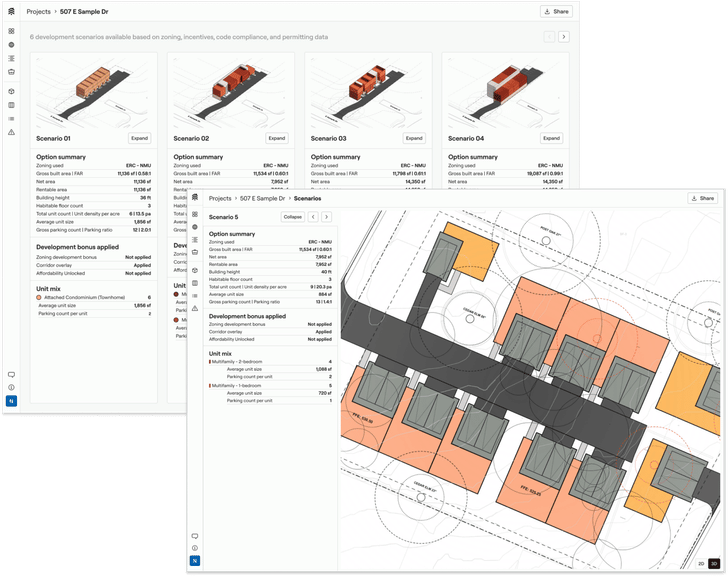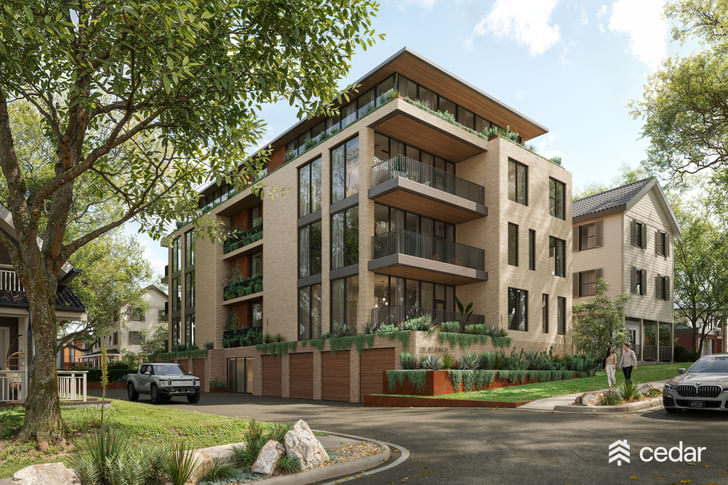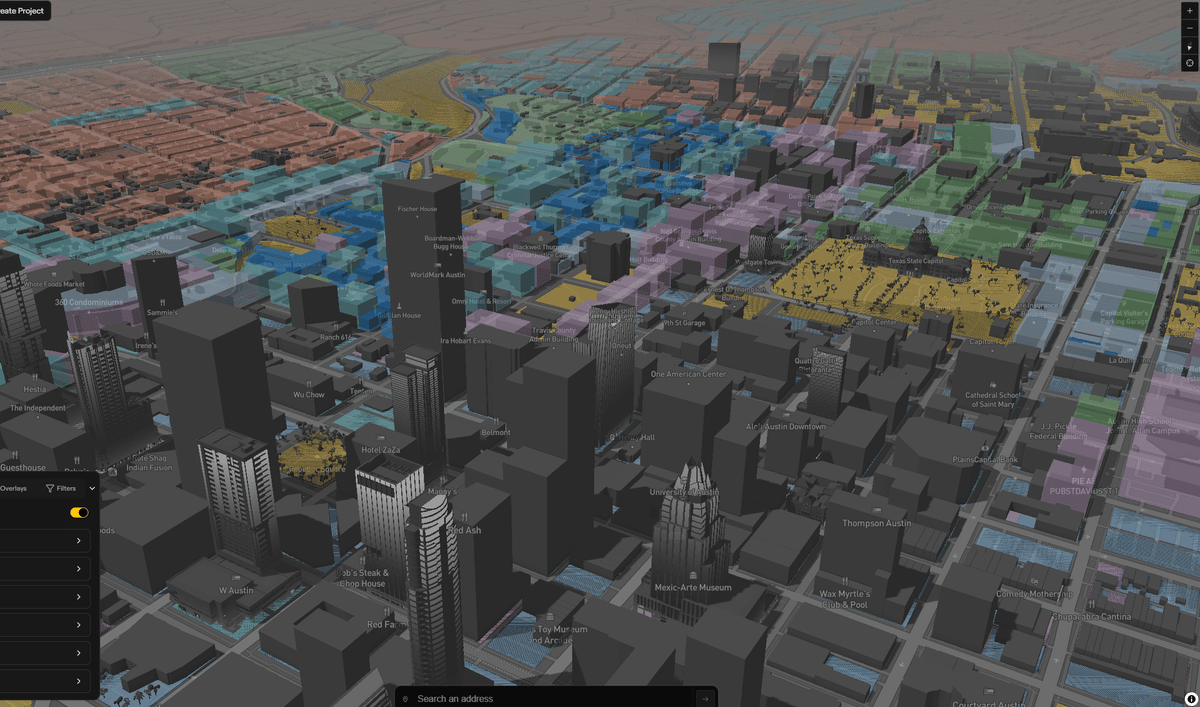Compliance zoning map. Image credit: Cedar
As breakthroughs in artificial intelligence continue to make global headlines and studies show a slow but noticeable uptake of AI across the architecture profession, we speak with one firm in Austin, Texas, which has designed its process around AI from the ground up. In our conversation with Cedar, we explore where the firm uses AI, why it does so, the challenges it faced when adopting AI, and advice for firms looking to expand their use of AI in practice.
AI and architecture in 2025
Most architects have tried using artificial intelligence, but few use it regularly. Such was the key finding of a report by the American Institute of Architects this year, which found via a survey that only 6% of the profession regularly uses AI for their projects. Meanwhile, 53% of architects have experimented with AI but have not started using it regularly.
Where architects do use AI, such use is typically confined to supportive rather than core design tasks. LLM chatbots are the most common source of AI use in practice, used by 79%, followed by image generators (50%), grammar/text analytics (45%), and transcription and meeting assistants (25%). Only 13% use AI design and planning tools, while 9% use AI for 3D modelling and 5% for project management tools.
Of the firms that are currently not using AI in any significant way, 52% told the AIA they lacked the time needed to explore the tools. In addition, 49% cited concerns over inaccuracy and authenticity, while 40% cited concerns over privacy and security. Finally, 39% cited a lack of interest, while 20% pointed to concerns about bias and discrimination.
At first glance, the slow adoption of AI in architecture may seem odd when measured against the bounty of headlines and commentary on AI’s widespread adoption across the U.S. economy. However, such headlines belie the particulars of architectural practice.
Where AI excels in predictive, controlled environments, the course of an architecture project is typically unpredictable, uncontrolled, and at the mercy of real-world variables from finance and politics to culture and nature.
Where AI excels in targeted, well-defined, isolated tasks, much of the architect’s work involves hierarchical thinking and the ability to perform many disparate, abstracted, seemingly unrelated tasks across several media in pursuit of a singular goal, often a building. Where AI models excel when trained on millions or billions of well-categorized data points, such standardized datasets are difficult to collect in architecture, where drawing conventions and representation can vary widely from firm to firm, or even within firms, from project to project. Where AI excels in predictive, controlled environments, the course of an architecture project is typically unpredictable, uncontrolled, and at the mercy of real-world variables from finance and politics to culture and nature.
Challenges such as these offer insight into why AI’s adoption in architecture is lagging behind other occupations and professions, and why many architects nurse concerns or apathy. However, an emerging suite of accessible, AI-powered tools tailored for architects may change this over the coming years. While familiar programs such as Adobe Creative Suite and Microsoft Office have begun integrating AI into existing software, new AI tools are emerging aimed at core design tasks, including Chaos’ Veras software for visualization and Autodesk’s Forma for early-stage design.
Speaking to Archinect last year as part of our Archinect In-Depth: Artificial Intelligence series, Autodesk’s Senior VP for Research Mike Haley set out the company’s vision for lowering the barrier to entry for architecture-specific AI tools, while author and researcher Randy Deutsch told us of his vision for architectural ‘superusers’ capable of traversing this growing portfolio of AI-powered tools. As new products come to market and the architect’s potential AI toolkit expands, the percentage of architects adopting AI is only set to increase. “AI will not replace architects,” our In-Depth series concluded last year, “but architects who use AI will replace those who do not.”
 Townhouses project. Image credit: CedarA full-stack architecture and AI company
Townhouses project. Image credit: CedarA full-stack architecture and AI company
How might architectural practice evolve in response to such innovations? One insight comes from Austin, Texas, where a group of architects and software engineers has come together to create a company incorporating AI from the ground up. Cedar describes itself as “an architecture firm within a technology company,” combining architectural thinking and computation to optimize the path from zoning to permit-ready design on urban infill projects.
“Most architects focus on bespoke, one-off projects that don’t scale, and the fragmented, billable-hours model of traditional practice makes it very difficult to take risk and adopt new technology, “ Cedar co-founder and CEO Kyle Vansice told Archinect. “At the same time, two major macro shifts were happening that created an opening for innovation and change. Advances in AI were finally producing reliable, creative tools to automate much of the tedious, rote work of practice. Zoning reforms were and are opening up millions of new opportunities for infill housing nationwide. Cedar was created at that intersection, a full-stack architecture and AI technology company designed to close the gap between feasibility, design, and permitting by building an architectural process of constant, data-driven improvement.”
We’ve achieved permitting timelines up to 6× faster than industry norms, and we’re turning design IP into a reusable “product catalog,” making great housing types repeatable while still adaptable to local conditions. — Vishal Vaidhyanathan, Cedar
Artificial intelligence is woven throughout Cedar’s operations. According to the team, AI’s biggest impact comes at the early feasibility stage, where they see decision-making as having the greatest leverage. The company’s in-house platform uses nationwide GIS and municipal data, alongside a design and site-planning knowledge model, to rapidly generate zoning-compliant development scenarios. As a result, developers working with the company can underwrite sites in minutes instead of weeks.
When a project is considered viable, the company once again turns to AI to create and adapt its growing catalog of data-driven building models, incorporating constraints such as topography, trees, and floodplains. The catalog, built to represent core building types as well as the firm’s design principles, is continually evolving with the addition of new design typologies and learnings from current and previous projects. Finally, the firm has automated construction documentation, once again making use of their catalog to rapidly generate compliant, permit-ready drawing sets and construction documentation. For Vishal Vaidhyanathan, Cedar’s Founding Engineer for Generative Systems and AI, the firm demonstrates that architecture can incorporate scalable and product-driven design processes that increase quality without losing soul.
 Site planning platform. Image credit: Cedar
Site planning platform. Image credit: Cedar
“Cedar has built a software platform that makes these processes scalable, measurable, and data-driven,” Vaidhyanathan told Archinect. “We’ve achieved permitting timelines up to 6x faster than industry norms, and we’re turning design IP into a reusable ‘product catalog,’ making great housing types repeatable while still adaptable to local conditions. This product-based model allows developers and builders to achieve the predictability, speed, and quality usually associated with manufacturing, not architecture.”
Like many voices in our Archinect: In-Depth: Artificial Intelligence series, Vaidhyanathan sees AI as a collaborator for architects, not a replacement. In Cedar’s workflows, AI and automation handle rules-based, repetitive aspects of the architectural process, such as zoning, code checks, and document generation. As a result, designers in the company can direct more energy to creativity, coordination, and design philosophy. For Vaidhyanathan, continuity is the key innovation offered by AI.
When we find a better layout, it improves the entire catalog. The result is a practice that learns continuously, and one that can respond to the scale of housing demand without abandoning the craft of architecture. — Vishal Vaidhyanathan, Cedar
“When a city changes its zoning, or a developer shifts their goals, our tools instantly adapt,” Vaidhyanathan explains. “When we find a better layout, it improves the entire catalog. The result is a practice that learns continuously, and one that can respond to the scale of housing demand without abandoning the craft of architecture. That’s the opportunity AI brings: To make architecture more accessible, more responsive, and more impactful than ever before.”
 Product catalog vignette. Image credit: CedarAdvice for the future
Product catalog vignette. Image credit: CedarAdvice for the future
Incorporating AI into Cedar’s workflows has not been without its challenges. For Vaidhyanathan, the hurdles have been cultural rather than technological. The firm often finds itself traversing two worlds: A slow-moving world of PDFs and email threads within an ecosystem of permitting, coordination, and consultants not as technologically advanced, and a fast-moving world of ever-evolving software and computational tools. So far, Cedar’s solutions have been centered on transparency; making design data structured, auditable, and code-compliant, allowing for quick alignment with engineers, landscape architects, and city officials who don’t directly use AI.
“Internally, it’s also been a mindset shift,” Vaidhyanathan added. “We’ve had to retrain ourselves to think in systems instead of drawings, asking ‘what’s the logic behind this design?’ rather than just ‘what does it look like?’ That’s a profound change in how architects work. But once you get there, it opens a much larger creative field. In many ways, the friction has been healthy. It forces us to clarify what matters, what truly requires a human hand, and what can be automated so we can spend more time on meaning, experience, and form.”
 Multi-family project. Image credit: Cedar
Multi-family project. Image credit: Cedar
Challenges aside, the firm nonetheless believes that AI will expand the market for architectural services by making design more accessible to a larger segment of the built environment. In that spirit, the firm’s outlook aligns with the ultimate conclusion from our In-Depth series, asserting that while the long-term impact of any technological breakthrough is uncertain, “AI is good for architects for now.”
AI can accelerate decision-making, but it cannot define values, aesthetics, or vision. The firms that succeed will balance automation with a strong, human-led design culture. — Nate Peters, Cedar
“The future of architecture with AI is productized, data-driven, and iterative, where design intelligence is embedded directly into digital systems that connect entitlement, design, and construction,” Cedar co-founder and CTO Nate Peters told Archinect. “The firms that thrive will be those that see AI not as a gimmick but as infrastructure, something that amplifies, rather than replaces, human expertise.”
For firms seeking to adopt AI into their own practice, Peters’ advice follows the overall theme of our conversation with Cedar: that of identifying existing inefficiencies while retaining a balance between automated and human-led duties.
“Start by mapping your repeatable workflows, the parts of your practice that rely on rules, data, or precedent,” Peters advises. “Those are ideal entry points for automation. Build small tools that remove friction, document results, and scale what works. Equally important: Keep design judgment at the center. AI can accelerate decision-making, but it cannot define values, aesthetics, or vision. The firms that succeed will balance automation with a strong, human-led design culture.”


